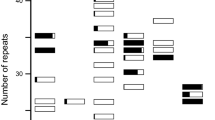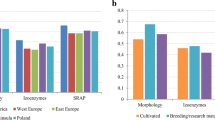Abstract
The “Sedano Nero di Trevi” (Black Celery from Trevi) is a landrace grown in Umbria (Italy) at risk of extinction. A morpho-physiological and molecular characterisation of the landrace and a detailed investigation of its cultural and cultivation context were carried out with the aim of facilitating a request for a quality mark, implement in situ (on farm) conservation schemes that are being developed in Italy and register the landrace in the European common catalogue of ‘conservation varieties’. These actions can help the landrace survive. Six farmer populations of the landrace and four élite varieties were characterised for thirteen morpho-physiological traits and nine AFLP primer combinations. The “Sedano Nero” farmer populations were better performers than élite varieties for important agronomic traits, such as yield, under the local agronomic conditions. Both morpho-physiological traits and molecular markers clearly distinguished the landrace from the élite cultivars. In addition, a structure was detected in the landrace with farmer populations being characterised by specific alleles. These results are discussed in connection with the local seed system and possible in situ conservation strategies for landraces.




Similar content being viewed by others
References
Acquadro A, Magurno F, Portis E, Lanteri S (2006) dbEST-derived microsatellite markers in celery (Apium graveolens L. var. dulce). Mol Ecol Notes 6:1080–1082
Aguado-Santacruz GA, Leyva-López NE, Péréz-Márquez KI, García-Moya E, Arredondo M, Martınez-Soriano JP (2004) Genetic variability of Bouteloua gracilis populations differing in forage production at the southernmost part of the North American Graminetum. Plant Ecol 170:287–299
Barsali E (1929) Prodromo della flora umbra. Nuovo Giornale Botanico Italiano 36:548–623
Barsali E (1931) Prodromo della flora umbra. Nuovo Giornale Botanico Italiano 38:624–689
Barsali E (1932) Prodromo della flora umbra. Nuovo Giornale Botanico Italiano 39(346–415):459–602
Batelli A (1886) Prima contribuzione alla flora umbra. Annali dell’Università Libera di Perugia (Anno I) 1:2–56
Batelli A (1887) Seconda contribuzione alla flora umbra. Annali dell’Università Libera di Perugia (Anno II) 2:136–248
Batelli A (1888) Terza contribuzione alla flora umbra. Annali dell’Università Libera di Perugia (Anno III) 2:29–46
Benham J, Jeung JU, Jasieniuk M et al (1999) Genographer: a graphical tool for automated fluorescent AFLP and microsatellite analysis. J Agric Genomics 4:1–3
Castellini G (2005) Caratterizzazione genetica di una varietà locale di sedano da costa Apium graveolens L. var. dulce (Miller) Pers. Università degli Studi di Perugia, Tesi di Dottorato di Ricerca, p 151
Chuang SJ, Chen CL, Chen JJ, Sung JM (2010) Using bulked AFLP analysis to assess genetic diversity in Echinacea species. Sci Hortic 124(3):400–404
Cicioni C (1895) La flora del Trasimeno: osservazioni generali. Tipografia Santucci, Perugia
de Vilmorin RL (1950) Pascal celery and its origin. J N Y Bot Gard 51:39–41
Domblides A, Domblides H, Kharchenko V (2008) Discrimination between celery cultivars with the use of RAPD markers. Proc Latvian Acad Sci B 62(6):219–222
Downie SR, Katz-Downie DS, Spalik K (2000) A phylogeny of Apiaceae tribe Scandiceae: evidence from nuclear ribosomal DNA internal transcribed spacer sequences. Am J Bot 87:76–95
Efron B (1979) Bootstrap methods: another look at the jackknife. Ann Stat 7(1):1–26
Excoffier L, Smouse PE, Quattro JM (1992) Analysis of molecular variance inferred from metric distances among DNA haplotypes; application to human mitochondrial DNA restriction data. Genetics 131:479–491
Guthridge KM, Dupal MP, Kölliker R, Jones ES, Smith KF, Forster JW (2001) AFLP analysis of genetic diversity within and between populations of perennial ryegrass (Lolium perenne). Euphytica 122:191–201
Hamrick JL, Godt MJW (1990) Allozyme diversity in plant species. In: Brown AHD, Clegg MT, Kahler AL, Sinauer BS Weir (eds), Plant population genetics, breeding and genetic resources. Sunderland, Massachusetts, pp 43–63
Helm J (1972) Apium graveolens L. Geschichte der Kultur und Taxonomie. Kulturpflanze 19:73–100
Huestis GM, Mcgrath JM, Quiros CF (1993) Development of genetic markers in celery based on restriction fragment length polymorphisms. Theor Appl Genet 85:889–896
Keivani M, Ramezanpour SS, Soltanloo H, Choukan R, Naghavi M, Ranjbar M (2011) Genetic diversity assessment of alfalfa populations using aflp markers. Am-Eurasian J Agric Environ Sci 10(1):119–126
Kölliker R, Jones ES, Jahaufer MZZ, Forster JW (2001) Bulked analysis for the assessment of genetic diversity in white clover (Trifolium repens L.). Euphytica 121:305–315
López JE, Oliveira JA (2012) Conservation of genetic diversity in regenerated landraces of Italian ryegrass. Plant Genet Resour 10:5–13. doi:10.1017/S147926211100089X
Mable BK, Adam A (2007) Patterns of genetic diversity in outcrossing and selfing populations of Arabidopsis lyrata. Mol Ecol 16:3565–3580. doi:10.1111/j.1365-294X.2007.03416.x
Mantel NA (1967) The detection of disease clustering and a generalized regression approach. Cancer Res 27:209–220
Marino M (2010) Implementazione del Piano Nazionale per la biodiversità in agricoltura. Dal Seme 4:37–41
Muminović J, Melchinger AE, Lubberstedt T (2004) Prospects for celeriac (Apium graveolens var. rapaceum) improvement by using genetic resources of Apium as determined by AFLP markers and morphological characterization. Plant Genetic Res 2(3):189–198
Nebauer SG, de Castillo-Agudo L, Segura J (1999) RAPD variation within and among populations of outcrossing willow-leaved foxglove (Digitalis obscura L.). Theor Appl Genet 98:985–994
Negri V (2012) Policies supportive of on-farm conservation and their impact on custodians farmers in Italy. In: Padulosi S, Bergamini N and Lawrence T (eds), On farm conservation of neglected and underutilized species: status, trends and novel approaches to cope with climate change. Proceedings of an International Conference, Frankfurt, 14–16 June 2011. Bioversity International, Rome, pp 211–216. ISBN 978-92-9043-907-3
Negri V, Maxted N, Vetelainen M (2009) European landrace conservation: an introduction. In: Vetelainen, M, Negri V, Maxted N (eds) ‘European landraces: on-farm conservation, management and use’. Bioversity technical bulletin No. 15, Bioversity International, Bioversity International publ., Rome, Italy, pp 1–22 ISBN 978-92-9043-805-2
Piergiovanni AR, Laghetti G (1999) The common bean landraces from Basilicata (Southern Italy): an example of integrated approach applied to genetic resources management. Genet Resour Crop Evol 46:47–52. doi:10.1023/A:1008641731573
Piergiovanni AR, Lioi L (2010) Italian common bean landraces: history, genetic diversity. Diversity 2:837–862. doi:10.3390/d2060837
Pimenov MG, Leonov MV (1993) The genera of the Umbelliferae. A nomenclator, Kew Royal Botanic Gardens, p 156
Polegri L, Negri V (2010) Molecular markers for promoting agro-biodiversity conservation: a case study from Italy. How cowpea landraces were saved from extinction. Genet Resour Crop Evol 57:867–880. doi:10.1007/s10722-009-9526-z
Porceddu A, Albertini E, Barcaccia G, Marconi G, Bertoli FB, Veronesi F (2002) Development of an S-SAP technique based on a LTR-like sequence of Medicago sativa L. Mol Genet Genomics 267:107–114
Portis E, Baudino M, Magurno F, Lanteri S (2012) Genetic structure and preservation strategies of autochthonous vegetable crop landraces of north-western Italy. Ann Appl Biol 160:76–85
Pusadee T, Jamjoda S, Chiangb Y-C, Rerkasema B, Schaalc BA (2009) Genetic structure and isolation by distance in a landrace of Thai rice. PNAS USA 106:13880–13885. doi:10.1073/pnas.0906720106
Quiros CF (1993) Celery–Apium graveolens L. In: Kalloo G, Bergh BO (eds) Genetic improvement of vegetable crops. Pergamon Press, Oxford, pp 523–534
Quiros CF, McGrath M, Stites JL (1987) Use of stem proteins and isozymes for the identification of celery varieties. Plant Cell Rep 6:114–117
Rick C (1988) Evolution of mating systems in cultivated plants. In: Gottlieband L, Jain S (eds) Plant evolutionary biology. Chapman and Hall, London, pp 133–147
Rohlf FJ (1993) NTSYS.PC. Numerical taxonomy and multivariate analysis system, Version 2.11Q. Applied biostatistics Inc, New York
Ronse A, Popper ZA, Preston JC, Watson MF (2010) Taxonomic revision of European Apium L. s.l.: Helosciadium W.D.J.Koch restored. Plant Syst Evol 287:1–17. doi:10.1007/s00606-010-0284-3
SAS Institute Inc. Copyright (1999–2001) by SAS Institute Inc., Cary, NC, USA. NOTE: SAS (r) Proprietary software release 8.2 (TS2M0)
Schneider S, Roessli D, Excoffier L (2000) Arlequin ver. 2000. A software for population genetics analysis. Genetic and Biometry Laboratory of Geneva, Switzerland
Segovia-Lerma A, Cantrell RG, Conway JM, Ray IM (2003) AFLP-based assessment of genetic diversity among nine alfalfa germplasms using bulk DNA templates. Genome 46:51–58. doi:10.1139/g02-100
Sneath PHA, Sokal RR (1973) Numerical taxanomy: the principles and practice of numerical classification. WH Freeman, San Francisco
Southern EM (1979) Measurement of DNA length by gel electrophoresis. Anal Biochem 100:319–323
Spataro G, Taviani P, Negri V (2007) Genetic variation and population structure in a Eurasian collection of Isatis tinctoria L. Genet Resour Crop Evol 54:573–584. doi:10.1007/s10722-006-0014-4
Spellani F (2008) La storia: Sedano Nero di Trevi e mostra mercato di ottobre. In: Castellini G, Filippucci G, Menghini A, Paggi A, Rapastella D, Ravagli T, Spellani F (eds) Il sedano nero di trevi. GraficArte Severini, Spoleto, pp 16–30
Steel RGD, Torrie JH (1980) Principles and procedures of statistics—a biometrical approach. McGraw-Hill Book Company, Inc., USA
Tiranti B, Negri V (2007) Selective micro-environmental effects play a role in shaping genetic diversity and structure in a Phaseolus vulgaris L. landrace: implications for on-farm conservation. Mol Ecol 16:4942–4955. doi:10.1111/j.1365-294X.2007.03566.x
Tosti N, Negri V (2005) On-going on-farm microevolutionary processes in neighbouring cowpea landraces revealed by molecular markers. Theor Appl Genet 110:1275–1283. doi:10.1007/s00122-005-1964-1
Vos P, Hogers R, Bleeker M, Reijans M, van de Lee T, Hornes M, Frijters A, Pot J, Peleman J, Kuiper M (1995) AFLP: a new technique for DNA fingerprinting. Nucleic Acids Res 23:4407–4414
Wang S, Yang W, Shen H (2011) Genetic diversity in Apium graveolens and related species revealed by SRAP and SSR markers. Sci Hortic 129:1–8
Whitlock MC, Barton WH (1997) The effective size of a subdivided population. Genetics 146:427–441
Yang X, Quiros C (1993) Identification and classification of celery cultivars with RAPD markers. Theor Appl Genet 86:205–212
Yap I, Nelson RJ (1996) WinBoot: a program for performing bootstrap analysis of binary data to determine the confidence limits of UPGMA-based dendrograms IRRI. Discussion paper series no.14, International Rice Research Institute, Manila, Philippines
Author information
Authors and Affiliations
Corresponding author
Electronic supplementary material
Below is the link to the electronic supplementary material.

10722_2012_9896_MOESM1_ESM.jpg
Supplementary material 1 (JPEG 1428 kb). Letter dated March 22nd, 1889: Don Giovanni Del Papa thanks the Trevi’s Mayor for having sent him celery seeds. Don G. Del Papa was the director of the ‘Colonia Agricola’ and of the ‘Collegio degli Artigianelli’ of the San Pietro Abbey in Perugia (former Fathers Benedettini Cassinesi Monastery). The seed was requested to initiate a new celery cultivation in the ‘Colonia Agricola’, the initial nucleus of the Faculty of Agriculture of Perugia University (that is still located there). Courtesy of the municipal archive of Trevi
Rights and permissions
About this article
Cite this article
Torricelli, R., Tiranti, B., Spataro, G. et al. Differentiation and structure of an Italian landrace of celery (Apium graveolens L.): inferences for on farm conservation. Genet Resour Crop Evol 60, 995–1006 (2013). https://doi.org/10.1007/s10722-012-9896-5
Received:
Accepted:
Published:
Issue Date:
DOI: https://doi.org/10.1007/s10722-012-9896-5




